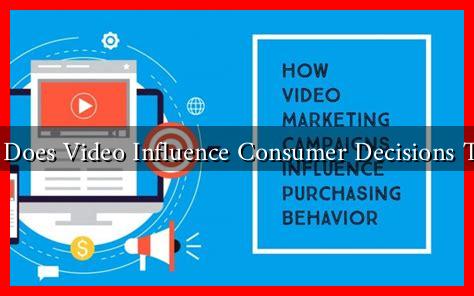-
Table of Contents
How Does Video Influence Consumer Decisions Today
In the digital age, video content has emerged as a powerful tool that significantly influences consumer behavior. With the rise of platforms like YouTube, TikTok, and Instagram, video marketing has become an essential strategy for brands aiming to engage their audience and drive sales. This article explores how video influences consumer decisions today, backed by research, statistics, and real-world examples.
The Power of Visual Storytelling
Video marketing leverages the power of visual storytelling to create emotional connections with consumers. Unlike static images or text, videos can convey complex messages quickly and effectively. According to a study by Wyzowl, 84% of consumers say they’ve been convinced to buy a product or service after watching a brand’s video.
Engagement and Retention Rates
One of the most compelling reasons for using video in marketing is its ability to engage viewers. Videos are more likely to be shared and remembered compared to other forms of content. Here are some statistics that highlight this trend:
- Videos are shared 1,200% more times than text and images combined.
- Viewers retain 95% of a message when they watch it in a video, compared to just 10% when reading it in text.
- Social media posts with videos receive 48% more views than those without.
These statistics underscore the importance of incorporating video into marketing strategies to enhance consumer engagement and retention.
Influencer Marketing and User-Generated Content
Influencer marketing has gained immense popularity, with brands collaborating with social media influencers to reach their target audience. Influencers often create video content that showcases products in a relatable context, making it easier for consumers to envision themselves using the product. For instance, beauty brands like Fenty Beauty have successfully utilized influencer partnerships to demonstrate their products through tutorials and reviews, leading to increased sales.
User-generated content (UGC) is another effective way to leverage video. Brands encourage customers to share their experiences through video testimonials or unboxing videos. This not only builds trust but also creates a sense of community around the brand. A study by Adobe found that 79% of consumers say user-generated content highly impacts their purchasing decisions.
Video as a Tool for Education and Information
Educational videos play a crucial role in the consumer decision-making process. Brands that provide informative content can position themselves as industry leaders and build trust with their audience. For example, companies like HubSpot create educational videos that help potential customers understand their products and services better. This approach not only informs consumers but also guides them through the sales funnel.
Live Streaming and Real-Time Engagement
Live streaming has become a popular way for brands to engage with consumers in real-time. Platforms like Facebook Live and Instagram Live allow brands to showcase products, answer questions, and interact with their audience instantly. This immediacy creates a sense of urgency and exclusivity, encouraging consumers to make quicker purchasing decisions. According to a report by Statista, the global live streaming market is expected to reach $247 billion by 2027.
Conclusion
In conclusion, video has become an indispensable tool in influencing consumer decisions today. Its ability to engage, educate, and connect with audiences makes it a powerful marketing strategy. As consumers increasingly turn to video for information and entertainment, brands must adapt their marketing strategies to include video content. By leveraging the power of visual storytelling, influencer partnerships, user-generated content, and live streaming, businesses can effectively influence consumer behavior and drive sales.
As the digital landscape continues to evolve, staying ahead of video marketing trends will be crucial for brands looking to thrive in a competitive marketplace.

